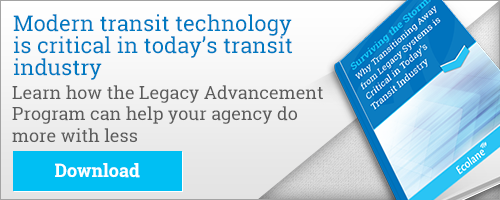As the largest generation of Americans born in U.S. history, Baby Boomers make up a significant portion of our population (75.4 million as of 2015 to be exact) and as a result, affect our culture and population trends. Baby Boomers are the generation of Americans born between 1946 (the end of WWII) and 1964.
As of June 2015, Millennials now outnumber Baby Boomers with 83.1 million people in the U.S. The two groups together make up the largest generations in our population and, interestingly enough, they are both moving in the same direction when it comes to public transportation.
Baby Boomers grew up using public transit, but now that most live in the suburbs or exurbs with limited transit options, they are using it less frequently. Instead, they rely on cars to get around. Now that Baby Boomers are aging, they will want to look towards alternative options as they transition out of cars. What implications does this have on the public transportation industry?
Follow the Baby Boomer Road
As mentioned above, Baby Boomers affect our current culture and social trends by simply representing such a large part of our population. The only other generation that has as great of an influence on our culture is the Millennials, who are huge advocates for public transportation. Since Baby Boomers will be looking less at driving their own vehicles and will search for alternative ways to get around, it becomes clear the transportation industry must adapt.
The suburbs offer Baby Boomers limited public transportation options unfortunately and investments must be made towards transit and infrastructure improvements to accommodate these needs. An AARP survey of more than 4,500 older adults indicates that half of Americans 50 and older want a bus stop within a mile of where they live. 23% also indicate they would like a train/subway close by, and wish more transportation would be added to communities for older adults and those with disabilities. If public transportation agencies want to increase ridership, they need to plan transit to the locations and destinations that Baby Boomers want to go.
Boomer Characteristics
The Baby Boomer generation grew up in a time where new technologies were becoming a reality almost daily and, as a result, it has impacted their lives signficantly. Additionally, the group is concerned about out-living their retirement assets (since they are entering the silver tsunami) and additionally, they are concerned about being able to care for their elderly parents.
To take advantage of these characteristics, public transit agencies need to utilize new technologies to support this generation. Adapting to new technology is less of a challenge to this demographic and they have seen how the industry has evolved throughout their lives. If transportation agencies take notice and begin working towards building infrastructure in Baby Boomer areas, implementing comprehensive transit software could be very beneficial. Additionally, agencies (especially PACE agencies) should be looking to not only develop infrastructure in these areas, but also develop specialized paratransit and demand-response transit. As for the Baby Boomer’s concern over their retirement assets, public transportation can be seen as a much more attractive and cost-effective alternative to driving for those looking to save.
For public transportation agencies, taking advantage of the changing needs of the Baby Boomer generation is critical. With Baby Boomers moving away from driving, and with one of the largest generations that make up our population looking towards public transportation, agencies need to respond. In order to improve and add services, transit systems need to see an increase in ridership and secure the necessary funding to continue to expand. In order to see this increase in ridership and be able to expand, agencies must develop infrastructure that meets the current demand.
About the Author

Ecolane
Read Ecolane's blog articles for perspective, opinion and information on transit and paratransit issues.
%20(200%20x%20100%20px).png)

